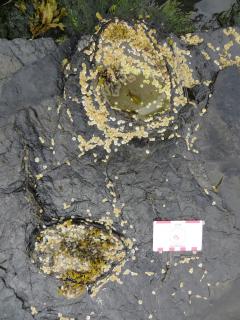They are among the most recognisable dinosaurs … now Edinburgh palaeontologists have discovered that stegosaurs left a lasting impression on a Scottish island.

Around 50 newly identified footprints on the Isle of Skye have helped scientists confirm that stegosaurs – with their distinctive diamond-shaped back plates – roamed there around 170 million year ago.
The site on the island’s north-east coast – which was at the time a mudflat on the edge of a shallow lagoon on a long-lost island in the Atlantic – contains a mixture of footprints, and reveals that dinosaurs on Skye were more diverse than previously thought.

Ancient tracks
A team of palaeontologists from the University discovered a short sequence of distinctive, oval footprints and handprints belonging to a stegosaur, left by a young animal or a small-bodied member of the stegosaur family as it ambled across the mudflat.
The discovery means that the site at Brothers’ Point – called Rubha nam Brathairean in Gaelic – is now recognised as one of the oldest-known fossil records of this major dinosaur group found anywhere in the world.
Large stegosaurs could grow to almost 30 feet long and weigh more than six tonnes.
Jurassic discoveries
Skye is one of the few places in the world were fossils from the Middle Jurassic period can be found.
Discoveries on the island have provided scientists with vital clues about the early evolution of major dinosaur groups, including huge, long-necked sauropods and fierce, meat-eating cousins of Tyrannosaurus rex.
These new tracksites help us get a better sense of the variety of dinosaurs that lived near the coast of Skye during the Middle Jurassic than what we can glean from the island’s body fossil record. In particular, Deltapodus tracks give good evidence that stegosaurs lived on Skye at this time.
Our findings give us a much clearer picture of the dinosaurs that lived in Scotland 170 million years ago. We knew there were giant long-necked sauropods and jeep-sized carnivores, but we can now add plate-backed stegosaurs to that roster, and maybe even primitive cousins of the duck-billed dinosaurs too. These discoveries are making Skye one of the best places in the world for understanding dinosaur evolution in the Middle Jurassic.
The study, published in the journal PLOS ONE, was supported by a grant from the ³Ô¹ÏÍøÕ¾ Geographic Society. It also involved scientists from ³Ô¹ÏÍøÕ¾ Museums Scotland, University of Glasgow, Federal University of Rio de Janeiro, and the Staffin Museum on the Isle of Skye.








